Adjusting Entries - Assignment
VerifiedAdded on 2021/01/05
|13
|2584
|22
AI Summary
Contribute Materials
Your contribution can guide someone’s learning journey. Share your
documents today.
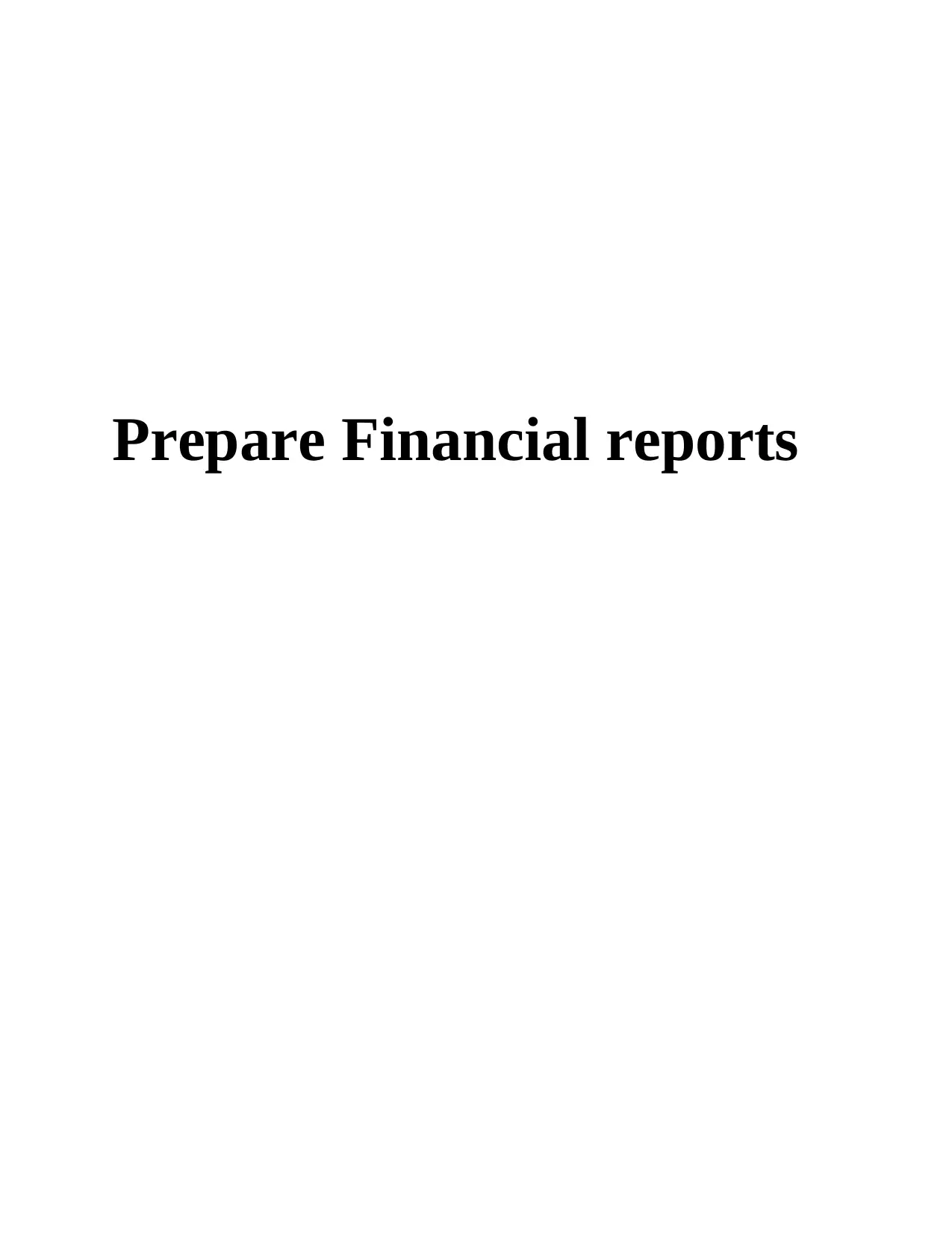
Prepare Financial reports
Secure Best Marks with AI Grader
Need help grading? Try our AI Grader for instant feedback on your assignments.
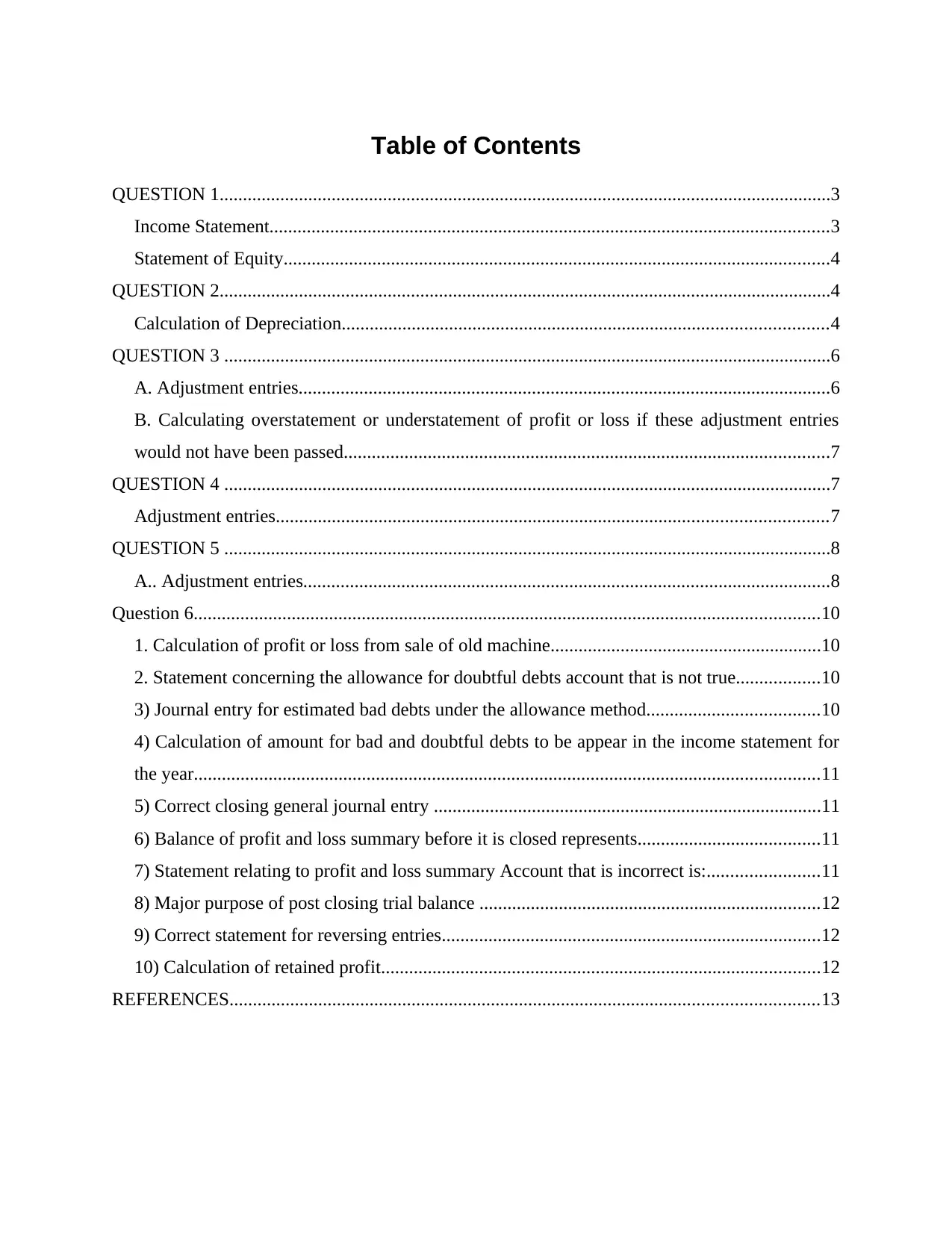
Table of Contents
QUESTION 1...................................................................................................................................3
Income Statement........................................................................................................................3
Statement of Equity.....................................................................................................................4
QUESTION 2...................................................................................................................................4
Calculation of Depreciation........................................................................................................4
QUESTION 3 ..................................................................................................................................6
A. Adjustment entries..................................................................................................................6
B. Calculating overstatement or understatement of profit or loss if these adjustment entries
would not have been passed........................................................................................................7
QUESTION 4 ..................................................................................................................................7
Adjustment entries......................................................................................................................7
QUESTION 5 ..................................................................................................................................8
A.. Adjustment entries.................................................................................................................8
Question 6......................................................................................................................................10
1. Calculation of profit or loss from sale of old machine..........................................................10
2. Statement concerning the allowance for doubtful debts account that is not true..................10
3) Journal entry for estimated bad debts under the allowance method.....................................10
4) Calculation of amount for bad and doubtful debts to be appear in the income statement for
the year......................................................................................................................................11
5) Correct closing general journal entry ...................................................................................11
6) Balance of profit and loss summary before it is closed represents.......................................11
7) Statement relating to profit and loss summary Account that is incorrect is:........................11
8) Major purpose of post closing trial balance .........................................................................12
9) Correct statement for reversing entries.................................................................................12
10) Calculation of retained profit..............................................................................................12
REFERENCES..............................................................................................................................13
QUESTION 1...................................................................................................................................3
Income Statement........................................................................................................................3
Statement of Equity.....................................................................................................................4
QUESTION 2...................................................................................................................................4
Calculation of Depreciation........................................................................................................4
QUESTION 3 ..................................................................................................................................6
A. Adjustment entries..................................................................................................................6
B. Calculating overstatement or understatement of profit or loss if these adjustment entries
would not have been passed........................................................................................................7
QUESTION 4 ..................................................................................................................................7
Adjustment entries......................................................................................................................7
QUESTION 5 ..................................................................................................................................8
A.. Adjustment entries.................................................................................................................8
Question 6......................................................................................................................................10
1. Calculation of profit or loss from sale of old machine..........................................................10
2. Statement concerning the allowance for doubtful debts account that is not true..................10
3) Journal entry for estimated bad debts under the allowance method.....................................10
4) Calculation of amount for bad and doubtful debts to be appear in the income statement for
the year......................................................................................................................................11
5) Correct closing general journal entry ...................................................................................11
6) Balance of profit and loss summary before it is closed represents.......................................11
7) Statement relating to profit and loss summary Account that is incorrect is:........................11
8) Major purpose of post closing trial balance .........................................................................12
9) Correct statement for reversing entries.................................................................................12
10) Calculation of retained profit..............................................................................................12
REFERENCES..............................................................................................................................13
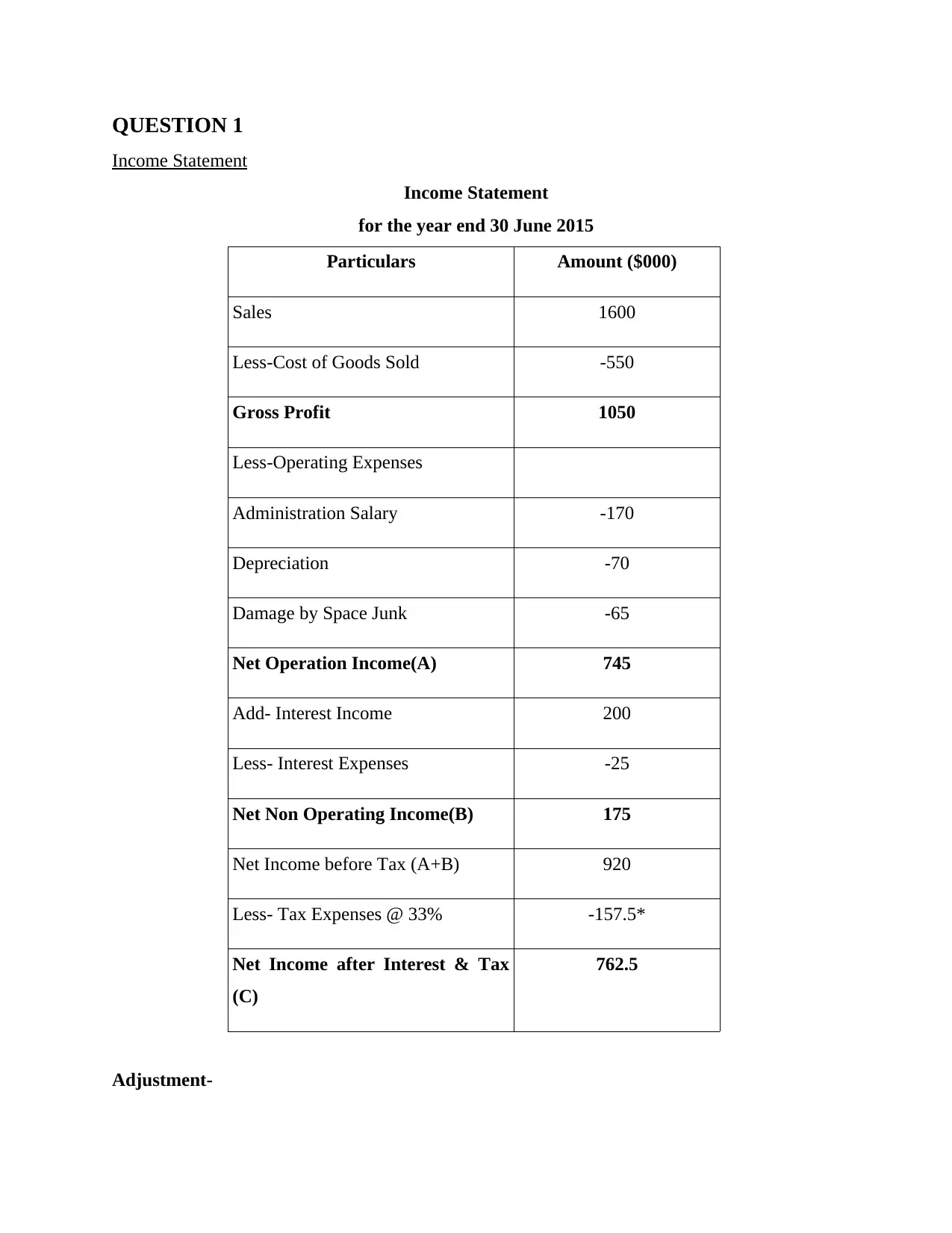
QUESTION 1
Income Statement
Income Statement
for the year end 30 June 2015
Particulars Amount ($000)
Sales 1600
Less-Cost of Goods Sold -550
Gross Profit 1050
Less-Operating Expenses
Administration Salary -170
Depreciation -70
Damage by Space Junk -65
Net Operation Income(A) 745
Add- Interest Income 200
Less- Interest Expenses -25
Net Non Operating Income(B) 175
Net Income before Tax (A+B) 920
Less- Tax Expenses @ 33% -157.5*
Net Income after Interest & Tax
(C)
762.5
Adjustment-
Income Statement
Income Statement
for the year end 30 June 2015
Particulars Amount ($000)
Sales 1600
Less-Cost of Goods Sold -550
Gross Profit 1050
Less-Operating Expenses
Administration Salary -170
Depreciation -70
Damage by Space Junk -65
Net Operation Income(A) 745
Add- Interest Income 200
Less- Interest Expenses -25
Net Non Operating Income(B) 175
Net Income before Tax (A+B) 920
Less- Tax Expenses @ 33% -157.5*
Net Income after Interest & Tax
(C)
762.5
Adjustment-
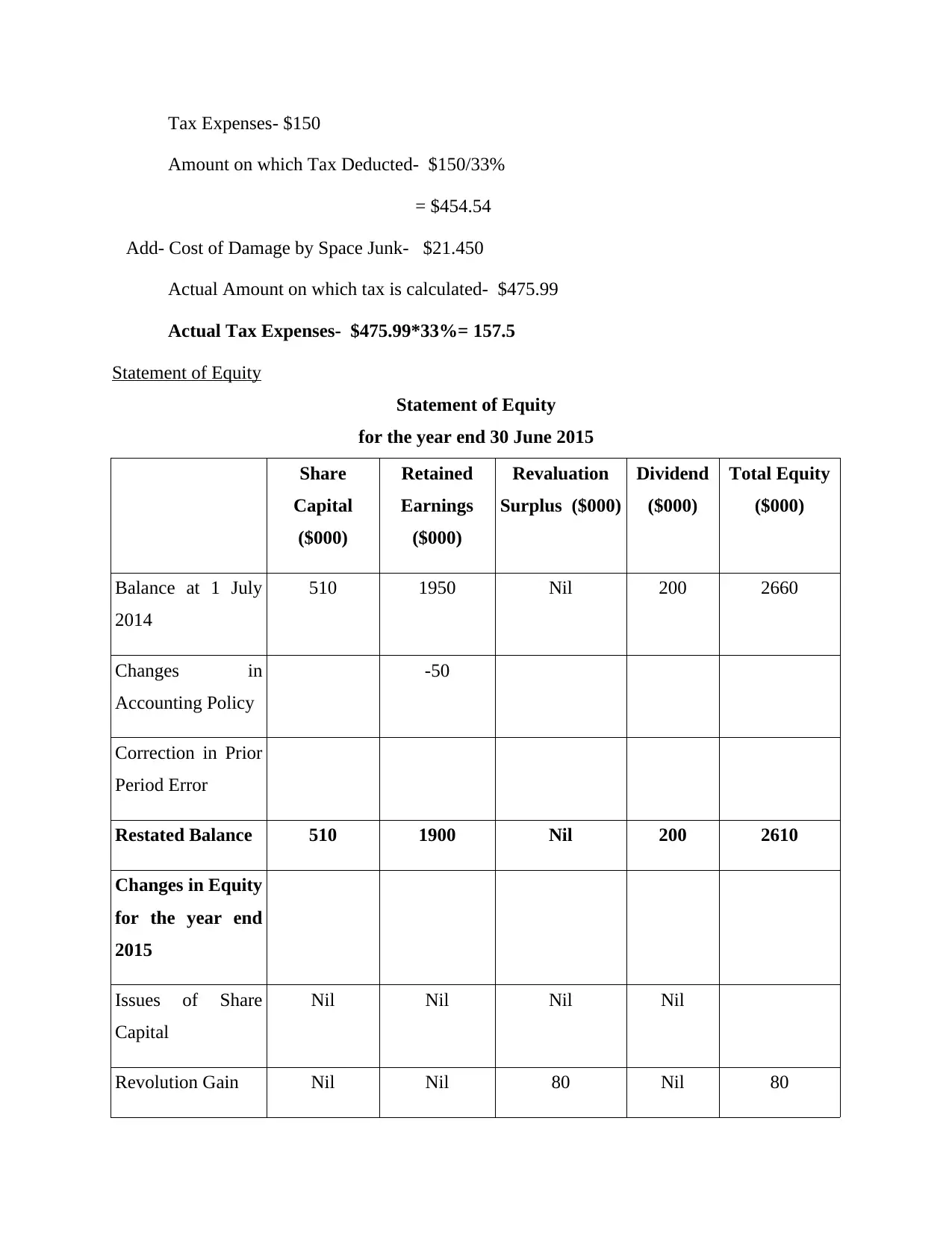
Tax Expenses- $150
Amount on which Tax Deducted- $150/33%
= $454.54
Add- Cost of Damage by Space Junk- $21.450
Actual Amount on which tax is calculated- $475.99
Actual Tax Expenses- $475.99*33%= 157.5
Statement of Equity
Statement of Equity
for the year end 30 June 2015
Share
Capital
($000)
Retained
Earnings
($000)
Revaluation
Surplus ($000)
Dividend
($000)
Total Equity
($000)
Balance at 1 July
2014
510 1950 Nil 200 2660
Changes in
Accounting Policy
-50
Correction in Prior
Period Error
Restated Balance 510 1900 Nil 200 2610
Changes in Equity
for the year end
2015
Issues of Share
Capital
Nil Nil Nil Nil
Revolution Gain Nil Nil 80 Nil 80
Amount on which Tax Deducted- $150/33%
= $454.54
Add- Cost of Damage by Space Junk- $21.450
Actual Amount on which tax is calculated- $475.99
Actual Tax Expenses- $475.99*33%= 157.5
Statement of Equity
Statement of Equity
for the year end 30 June 2015
Share
Capital
($000)
Retained
Earnings
($000)
Revaluation
Surplus ($000)
Dividend
($000)
Total Equity
($000)
Balance at 1 July
2014
510 1950 Nil 200 2660
Changes in
Accounting Policy
-50
Correction in Prior
Period Error
Restated Balance 510 1900 Nil 200 2610
Changes in Equity
for the year end
2015
Issues of Share
Capital
Nil Nil Nil Nil
Revolution Gain Nil Nil 80 Nil 80
Secure Best Marks with AI Grader
Need help grading? Try our AI Grader for instant feedback on your assignments.

Balance at 30
June 2015
510 1900 80 200 2690
Sources:(Statement of Changes in Equity. 2017)
QUESTION 2
Calculation of Depreciation
Straight-line method
Purchase Cost of Machinery $29 000
Estimated Salvage Value $7000
Rate of Depreciation (1/3 years) 33.33%
Formula- (Purchase Cost- Residual Value)*Rate of Depreciation
Depreciation Expenses= (29000-7000)*33.33%
=$14667.4
Sum-of-Digits Method
Year Depreciation
Base
Remaining
Useful Life
Depreciation
Fraction
Depreciation
Expenses
Book Value
1 $22000 7 25.00% $5500 $16500
2 $22000 6 21.42% $4714.28 $17285.72
3 $22000 5 17.85% $3928.57 $18071.43
4 $22000 4 14.28% $3142.85 $18857.15
5 $22000 3 10.71% $2357.14 $19642.86
6 $22000 2 7.14% $1571.42 $20428.58
June 2015
510 1900 80 200 2690
Sources:(Statement of Changes in Equity. 2017)
QUESTION 2
Calculation of Depreciation
Straight-line method
Purchase Cost of Machinery $29 000
Estimated Salvage Value $7000
Rate of Depreciation (1/3 years) 33.33%
Formula- (Purchase Cost- Residual Value)*Rate of Depreciation
Depreciation Expenses= (29000-7000)*33.33%
=$14667.4
Sum-of-Digits Method
Year Depreciation
Base
Remaining
Useful Life
Depreciation
Fraction
Depreciation
Expenses
Book Value
1 $22000 7 25.00% $5500 $16500
2 $22000 6 21.42% $4714.28 $17285.72
3 $22000 5 17.85% $3928.57 $18071.43
4 $22000 4 14.28% $3142.85 $18857.15
5 $22000 3 10.71% $2357.14 $19642.86
6 $22000 2 7.14% $1571.42 $20428.58
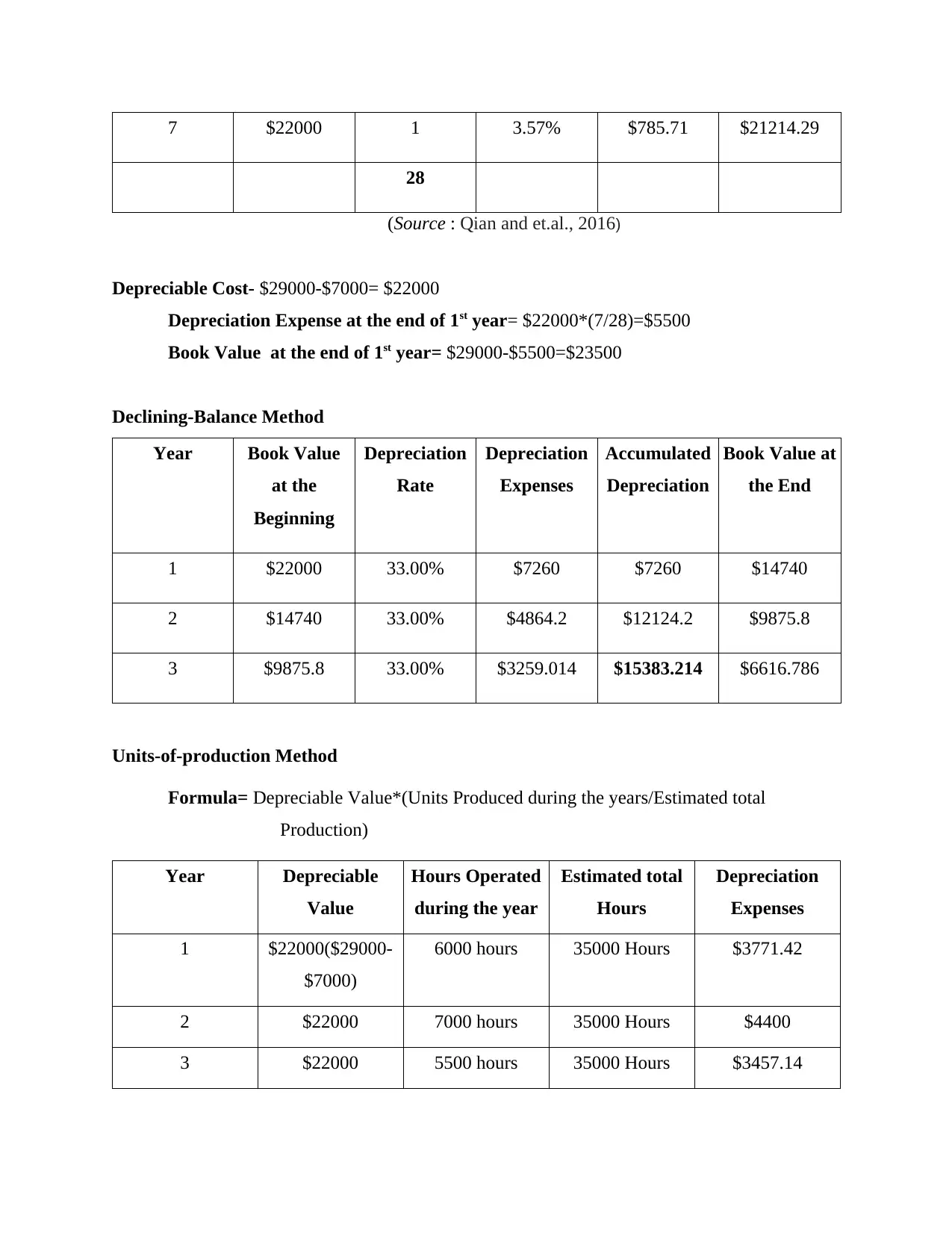
7 $22000 1 3.57% $785.71 $21214.29
28
(Source : Qian and et.al., 2016)
Depreciable Cost- $29000-$7000= $22000
Depreciation Expense at the end of 1st year= $22000*(7/28)=$5500
Book Value at the end of 1st year= $29000-$5500=$23500
Declining-Balance Method
Year Book Value
at the
Beginning
Depreciation
Rate
Depreciation
Expenses
Accumulated
Depreciation
Book Value at
the End
1 $22000 33.00% $7260 $7260 $14740
2 $14740 33.00% $4864.2 $12124.2 $9875.8
3 $9875.8 33.00% $3259.014 $15383.214 $6616.786
Units-of-production Method
Formula= Depreciable Value*(Units Produced during the years/Estimated total
Production)
Year Depreciable
Value
Hours Operated
during the year
Estimated total
Hours
Depreciation
Expenses
1 $22000($29000-
$7000)
6000 hours 35000 Hours $3771.42
2 $22000 7000 hours 35000 Hours $4400
3 $22000 5500 hours 35000 Hours $3457.14
28
(Source : Qian and et.al., 2016)
Depreciable Cost- $29000-$7000= $22000
Depreciation Expense at the end of 1st year= $22000*(7/28)=$5500
Book Value at the end of 1st year= $29000-$5500=$23500
Declining-Balance Method
Year Book Value
at the
Beginning
Depreciation
Rate
Depreciation
Expenses
Accumulated
Depreciation
Book Value at
the End
1 $22000 33.00% $7260 $7260 $14740
2 $14740 33.00% $4864.2 $12124.2 $9875.8
3 $9875.8 33.00% $3259.014 $15383.214 $6616.786
Units-of-production Method
Formula= Depreciable Value*(Units Produced during the years/Estimated total
Production)
Year Depreciable
Value
Hours Operated
during the year
Estimated total
Hours
Depreciation
Expenses
1 $22000($29000-
$7000)
6000 hours 35000 Hours $3771.42
2 $22000 7000 hours 35000 Hours $4400
3 $22000 5500 hours 35000 Hours $3457.14
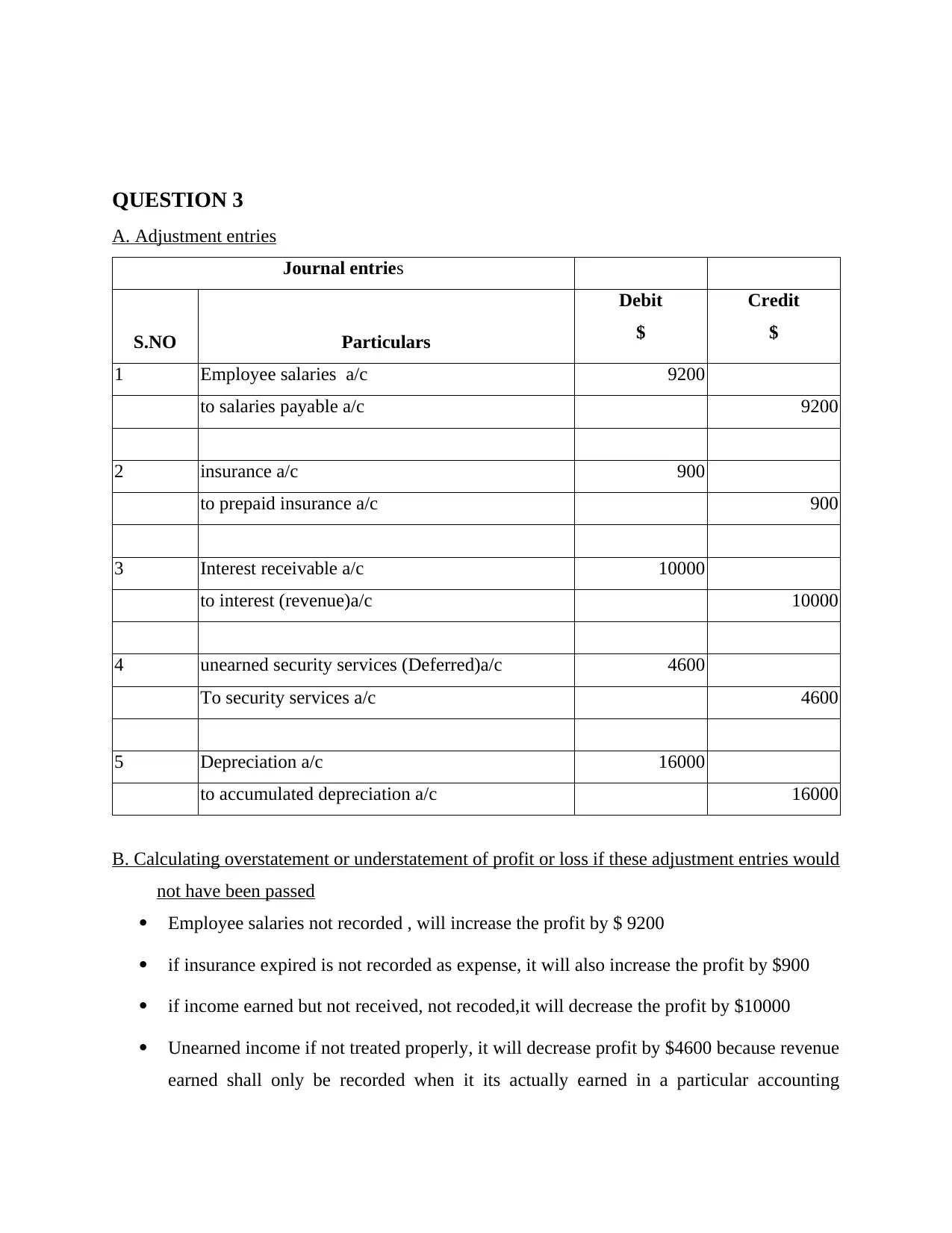
QUESTION 3
A. Adjustment entries
Journal entries
S.NO Particulars
Debit
$
Credit
$
1 Employee salaries a/c 9200
to salaries payable a/c 9200
2 insurance a/c 900
to prepaid insurance a/c 900
3 Interest receivable a/c 10000
to interest (revenue)a/c 10000
4 unearned security services (Deferred)a/c 4600
To security services a/c 4600
5 Depreciation a/c 16000
to accumulated depreciation a/c 16000
B. Calculating overstatement or understatement of profit or loss if these adjustment entries would
not have been passed
Employee salaries not recorded , will increase the profit by $ 9200
if insurance expired is not recorded as expense, it will also increase the profit by $900
if income earned but not received, not recoded,it will decrease the profit by $10000
Unearned income if not treated properly, it will decrease profit by $4600 because revenue
earned shall only be recorded when it its actually earned in a particular accounting
A. Adjustment entries
Journal entries
S.NO Particulars
Debit
$
Credit
$
1 Employee salaries a/c 9200
to salaries payable a/c 9200
2 insurance a/c 900
to prepaid insurance a/c 900
3 Interest receivable a/c 10000
to interest (revenue)a/c 10000
4 unearned security services (Deferred)a/c 4600
To security services a/c 4600
5 Depreciation a/c 16000
to accumulated depreciation a/c 16000
B. Calculating overstatement or understatement of profit or loss if these adjustment entries would
not have been passed
Employee salaries not recorded , will increase the profit by $ 9200
if insurance expired is not recorded as expense, it will also increase the profit by $900
if income earned but not received, not recoded,it will decrease the profit by $10000
Unearned income if not treated properly, it will decrease profit by $4600 because revenue
earned shall only be recorded when it its actually earned in a particular accounting
Paraphrase This Document
Need a fresh take? Get an instant paraphrase of this document with our AI Paraphraser
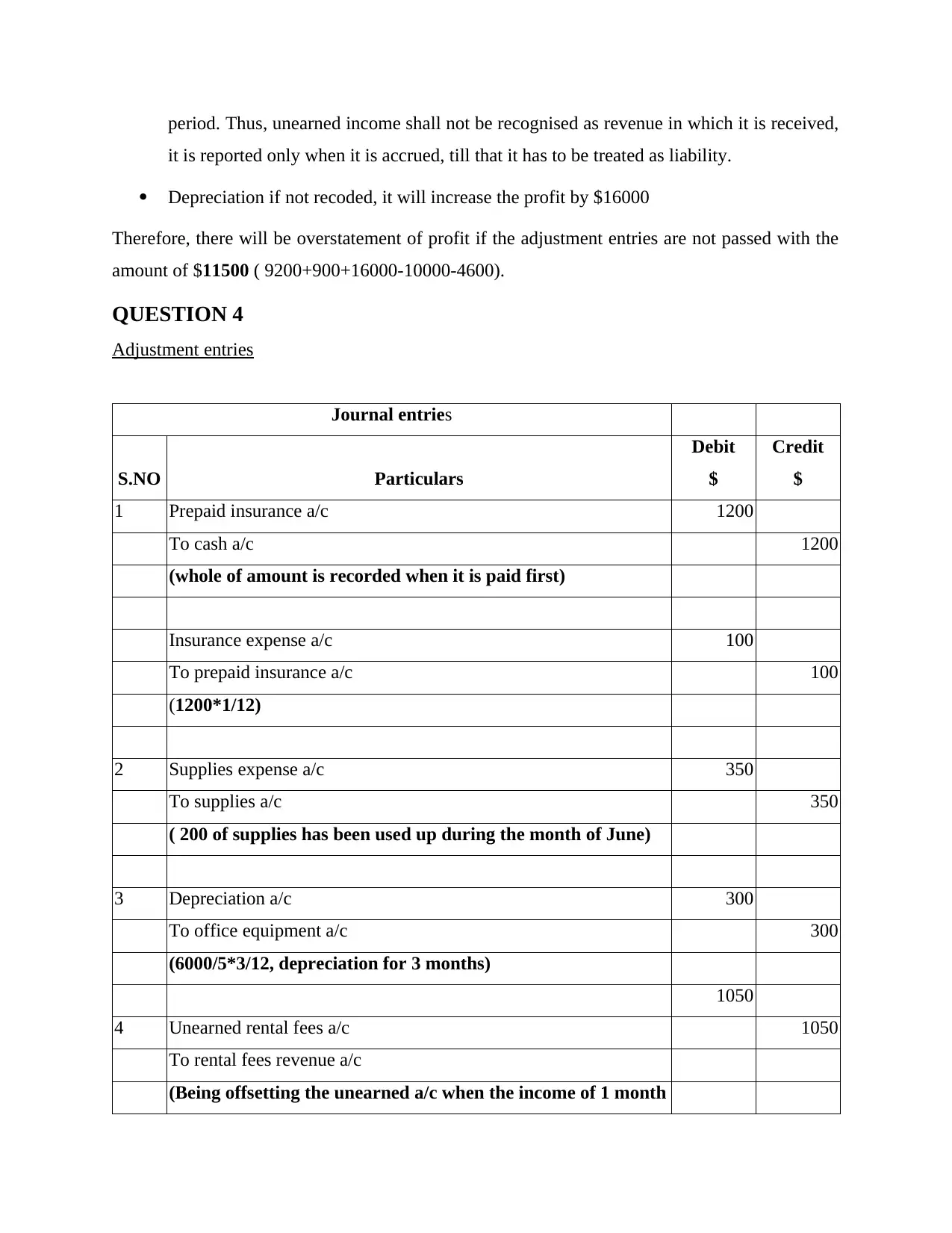
period. Thus, unearned income shall not be recognised as revenue in which it is received,
it is reported only when it is accrued, till that it has to be treated as liability.
Depreciation if not recoded, it will increase the profit by $16000
Therefore, there will be overstatement of profit if the adjustment entries are not passed with the
amount of $11500 ( 9200+900+16000-10000-4600).
QUESTION 4
Adjustment entries
Journal entries
S.NO Particulars
Debit
$
Credit
$
1 Prepaid insurance a/c 1200
To cash a/c 1200
(whole of amount is recorded when it is paid first)
Insurance expense a/c 100
To prepaid insurance a/c 100
(1200*1/12)
2 Supplies expense a/c 350
To supplies a/c 350
( 200 of supplies has been used up during the month of June)
3 Depreciation a/c 300
To office equipment a/c 300
(6000/5*3/12, depreciation for 3 months)
1050
4 Unearned rental fees a/c 1050
To rental fees revenue a/c
(Being offsetting the unearned a/c when the income of 1 month
it is reported only when it is accrued, till that it has to be treated as liability.
Depreciation if not recoded, it will increase the profit by $16000
Therefore, there will be overstatement of profit if the adjustment entries are not passed with the
amount of $11500 ( 9200+900+16000-10000-4600).
QUESTION 4
Adjustment entries
Journal entries
S.NO Particulars
Debit
$
Credit
$
1 Prepaid insurance a/c 1200
To cash a/c 1200
(whole of amount is recorded when it is paid first)
Insurance expense a/c 100
To prepaid insurance a/c 100
(1200*1/12)
2 Supplies expense a/c 350
To supplies a/c 350
( 200 of supplies has been used up during the month of June)
3 Depreciation a/c 300
To office equipment a/c 300
(6000/5*3/12, depreciation for 3 months)
1050
4 Unearned rental fees a/c 1050
To rental fees revenue a/c
(Being offsetting the unearned a/c when the income of 1 month

accrues on 30 June , rent of month 4200*1/4, balance of
revenue a/c = 14250)
5 Salaries a/c 3500
To accrued salary a/c 3500
( Total salary payable is 29800+3500= 33300)
QUESTION 5
A.. Adjustment entries
Journal entries
Date Particulars Debit Credit
1 Rent expense a/c 406
To rent payable a/c 406
2 Telephone expenses a/c 147
To telephone expense payable a/c 147
1407
3 Supplies expense a/c 1407
to supplies a/c
400
4 Interest expense a/c 400
To interest payable a/c
5 depreciation account Dr. 6580
revenue a/c = 14250)
5 Salaries a/c 3500
To accrued salary a/c 3500
( Total salary payable is 29800+3500= 33300)
QUESTION 5
A.. Adjustment entries
Journal entries
Date Particulars Debit Credit
1 Rent expense a/c 406
To rent payable a/c 406
2 Telephone expenses a/c 147
To telephone expense payable a/c 147
1407
3 Supplies expense a/c 1407
to supplies a/c
400
4 Interest expense a/c 400
To interest payable a/c
5 depreciation account Dr. 6580
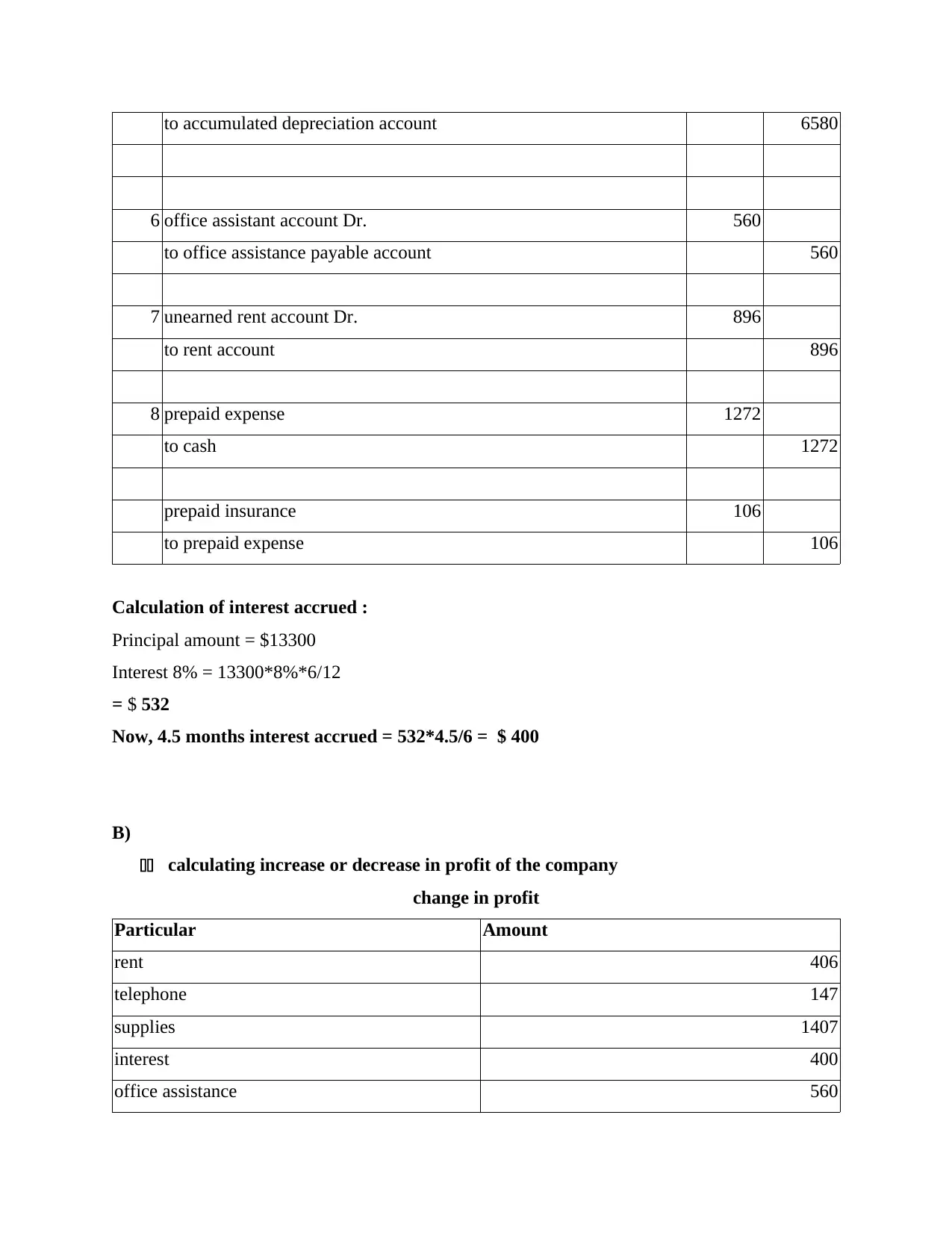
to accumulated depreciation account 6580
6 office assistant account Dr. 560
to office assistance payable account 560
7 unearned rent account Dr. 896
to rent account 896
8 prepaid expense 1272
to cash 1272
prepaid insurance 106
to prepaid expense 106
Calculation of interest accrued :
Principal amount = $13300
Interest 8% = 13300*8%*6/12
= $ 532
Now, 4.5 months interest accrued = 532*4.5/6 = $ 400
B)
11 calculating increase or decrease in profit of the company
change in profit
Particular Amount
rent 406
telephone 147
supplies 1407
interest 400
office assistance 560
6 office assistant account Dr. 560
to office assistance payable account 560
7 unearned rent account Dr. 896
to rent account 896
8 prepaid expense 1272
to cash 1272
prepaid insurance 106
to prepaid expense 106
Calculation of interest accrued :
Principal amount = $13300
Interest 8% = 13300*8%*6/12
= $ 532
Now, 4.5 months interest accrued = 532*4.5/6 = $ 400
B)
11 calculating increase or decrease in profit of the company
change in profit
Particular Amount
rent 406
telephone 147
supplies 1407
interest 400
office assistance 560
Secure Best Marks with AI Grader
Need help grading? Try our AI Grader for instant feedback on your assignments.

net decrease 2920
2. increase or decrease in liability and assets
change in asset
Particular Amount
supplies 1407
prepaid expenses 0
prepaid insurance expired -106
net increase 1301
note: neutral effect of prepaid expenses as one asset is decreasing and other asset is
increasing with same amount
change in liability
Particular Amount
rent 406
telephone 147
interest 400
accumulated depreciation 6580
office assistance 560
advance rent 896
net increase 8989
Question 6
1. Calculation of profit or loss from sale of old machine
particular amount
cost of machinery 3000
less:
accumulated
depreciation 1400
net book value 1600
less: sale 2000
profit from sale 400
2. increase or decrease in liability and assets
change in asset
Particular Amount
supplies 1407
prepaid expenses 0
prepaid insurance expired -106
net increase 1301
note: neutral effect of prepaid expenses as one asset is decreasing and other asset is
increasing with same amount
change in liability
Particular Amount
rent 406
telephone 147
interest 400
accumulated depreciation 6580
office assistance 560
advance rent 896
net increase 8989
Question 6
1. Calculation of profit or loss from sale of old machine
particular amount
cost of machinery 3000
less:
accumulated
depreciation 1400
net book value 1600
less: sale 2000
profit from sale 400
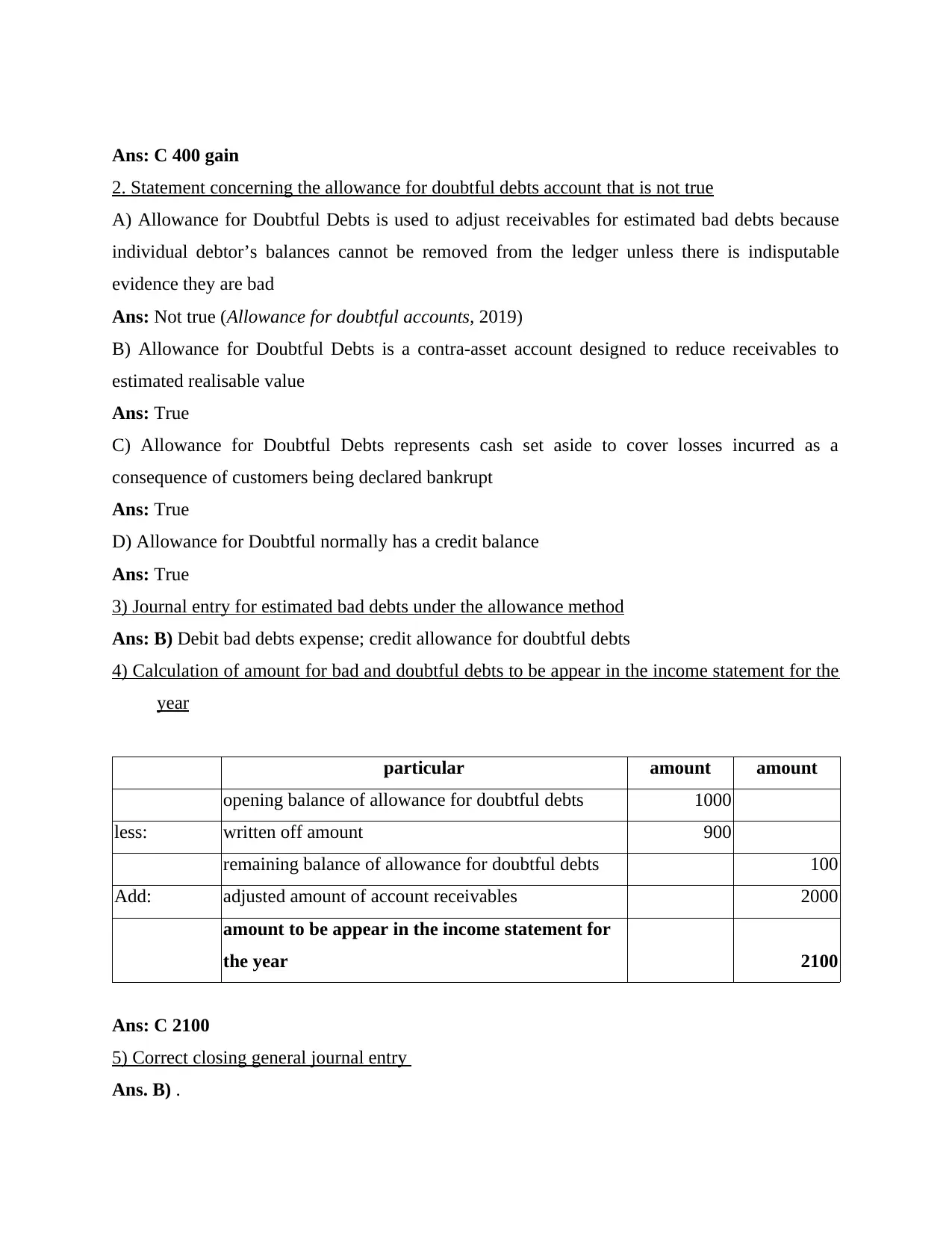
Ans: C 400 gain
2. Statement concerning the allowance for doubtful debts account that is not true
A) Allowance for Doubtful Debts is used to adjust receivables for estimated bad debts because
individual debtor’s balances cannot be removed from the ledger unless there is indisputable
evidence they are bad
Ans: Not true (Allowance for doubtful accounts, 2019)
B) Allowance for Doubtful Debts is a contra-asset account designed to reduce receivables to
estimated realisable value
Ans: True
C) Allowance for Doubtful Debts represents cash set aside to cover losses incurred as a
consequence of customers being declared bankrupt
Ans: True
D) Allowance for Doubtful normally has a credit balance
Ans: True
3) Journal entry for estimated bad debts under the allowance method
Ans: B) Debit bad debts expense; credit allowance for doubtful debts
4) Calculation of amount for bad and doubtful debts to be appear in the income statement for the
year
particular amount amount
opening balance of allowance for doubtful debts 1000
less: written off amount 900
remaining balance of allowance for doubtful debts 100
Add: adjusted amount of account receivables 2000
amount to be appear in the income statement for
the year 2100
Ans: C 2100
5) Correct closing general journal entry
Ans. B) .
2. Statement concerning the allowance for doubtful debts account that is not true
A) Allowance for Doubtful Debts is used to adjust receivables for estimated bad debts because
individual debtor’s balances cannot be removed from the ledger unless there is indisputable
evidence they are bad
Ans: Not true (Allowance for doubtful accounts, 2019)
B) Allowance for Doubtful Debts is a contra-asset account designed to reduce receivables to
estimated realisable value
Ans: True
C) Allowance for Doubtful Debts represents cash set aside to cover losses incurred as a
consequence of customers being declared bankrupt
Ans: True
D) Allowance for Doubtful normally has a credit balance
Ans: True
3) Journal entry for estimated bad debts under the allowance method
Ans: B) Debit bad debts expense; credit allowance for doubtful debts
4) Calculation of amount for bad and doubtful debts to be appear in the income statement for the
year
particular amount amount
opening balance of allowance for doubtful debts 1000
less: written off amount 900
remaining balance of allowance for doubtful debts 100
Add: adjusted amount of account receivables 2000
amount to be appear in the income statement for
the year 2100
Ans: C 2100
5) Correct closing general journal entry
Ans. B) .
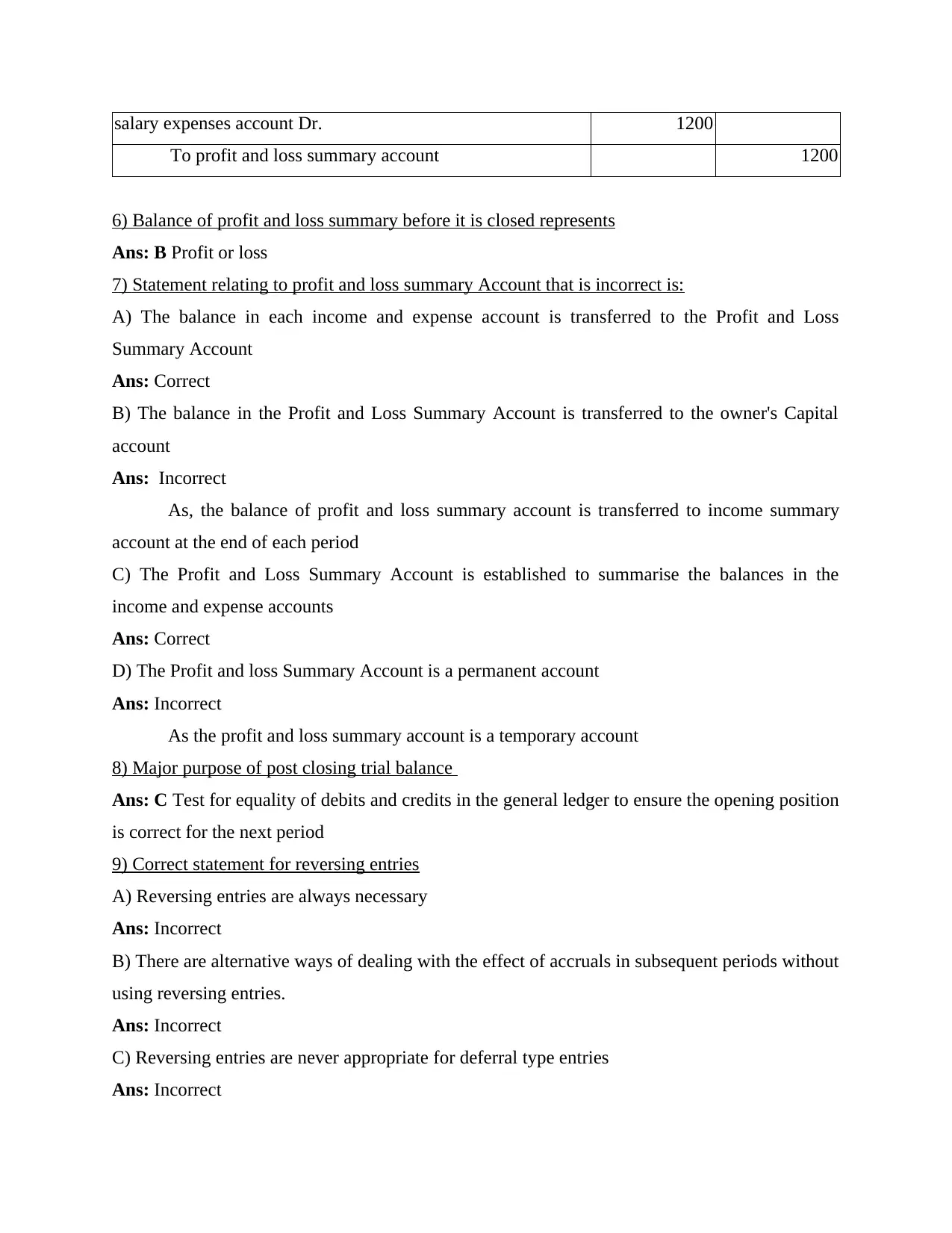
salary expenses account Dr. 1200
To profit and loss summary account 1200
6) Balance of profit and loss summary before it is closed represents
Ans: B Profit or loss
7) Statement relating to profit and loss summary Account that is incorrect is:
A) The balance in each income and expense account is transferred to the Profit and Loss
Summary Account
Ans: Correct
B) The balance in the Profit and Loss Summary Account is transferred to the owner's Capital
account
Ans: Incorrect
As, the balance of profit and loss summary account is transferred to income summary
account at the end of each period
C) The Profit and Loss Summary Account is established to summarise the balances in the
income and expense accounts
Ans: Correct
D) The Profit and loss Summary Account is a permanent account
Ans: Incorrect
As the profit and loss summary account is a temporary account
8) Major purpose of post closing trial balance
Ans: C Test for equality of debits and credits in the general ledger to ensure the opening position
is correct for the next period
9) Correct statement for reversing entries
A) Reversing entries are always necessary
Ans: Incorrect
B) There are alternative ways of dealing with the effect of accruals in subsequent periods without
using reversing entries.
Ans: Incorrect
C) Reversing entries are never appropriate for deferral type entries
Ans: Incorrect
To profit and loss summary account 1200
6) Balance of profit and loss summary before it is closed represents
Ans: B Profit or loss
7) Statement relating to profit and loss summary Account that is incorrect is:
A) The balance in each income and expense account is transferred to the Profit and Loss
Summary Account
Ans: Correct
B) The balance in the Profit and Loss Summary Account is transferred to the owner's Capital
account
Ans: Incorrect
As, the balance of profit and loss summary account is transferred to income summary
account at the end of each period
C) The Profit and Loss Summary Account is established to summarise the balances in the
income and expense accounts
Ans: Correct
D) The Profit and loss Summary Account is a permanent account
Ans: Incorrect
As the profit and loss summary account is a temporary account
8) Major purpose of post closing trial balance
Ans: C Test for equality of debits and credits in the general ledger to ensure the opening position
is correct for the next period
9) Correct statement for reversing entries
A) Reversing entries are always necessary
Ans: Incorrect
B) There are alternative ways of dealing with the effect of accruals in subsequent periods without
using reversing entries.
Ans: Incorrect
C) Reversing entries are never appropriate for deferral type entries
Ans: Incorrect
1 out of 13
Related Documents
Your All-in-One AI-Powered Toolkit for Academic Success.
+13062052269
info@desklib.com
Available 24*7 on WhatsApp / Email
![[object Object]](/_next/static/media/star-bottom.7253800d.svg)
Unlock your academic potential
© 2024 | Zucol Services PVT LTD | All rights reserved.




